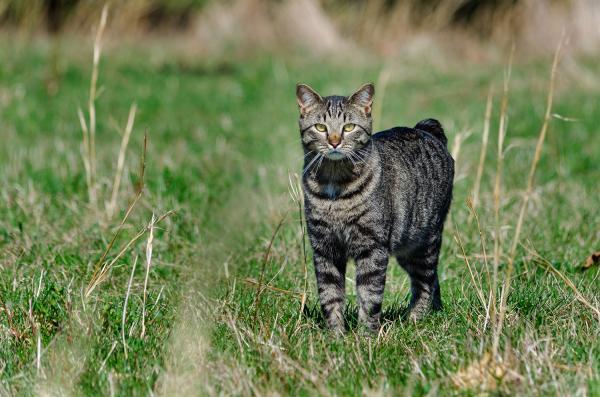Manx cat: Breed Personality, Behavior Facts and Characteristics, Health Care Info

The manx cat is one of the most peculiar for its tail and general physical appearance. Tender looking and fluffy mantle, this feline race has won the hearts of many people for its balanced and affectionate nature. However, to make the animal happy, it is necessary to know all the characteristics of the cat manx, its basic care, its temperament and possible health problems. Therefore, in this article, we share Everything you need to know about the manx cat if you are considering living with one or you have already adopted it.
Origin of the manx cat
The manx cat is originally from the Isle of Man, which is situated between Ireland and Great Britain. Its name is shared with the natives of the island, since “manx” means “manés”, that is, the name for locals on the island, and it is one of the most popular breeds worldwide.
There various legends about the cause of his absence of tail. One of them tells that when Noah closed the doors of his famous ark, he caught the tail of a cat that had been delayed hunting a mouse to entertain Noah, becoming this the first Manx cat. Others claim that the tail lost it because a motorcycle passed over it, which is explained by the high number of motorcycles that circulate around the island. And even a different one says that this breed comes from a cross between a cat and a rabbit.
Regardless of the myths and legends that surround the origin of the manx cat, the reason for the existence of these cats is believed to be in the old spanish galleons that they always had cats on board to hunt mice. It is believed that they came to the Isle of Man and underwent natural mutation there, which they transferred to the following generations.
Physical characteristics of the manx cat
One of the most peculiar physical characteristics of the manx cat is the tail. Although it has traditionally been a cat whose tail is absent, currently and since the length and presence or not of the same varies from one specimen to another, we can distinguish five types of manx cats according to the tail who have:
- Rumpy: in these felines the absence of tail is total, presenting a hole at the end of the spine.
- Rumpy riser: in this case what can be taken by a tail signal is actually a lengthening of the sacral bone that tilts upwards.
- Stumpy: it is the presence of a vestigial tail, no more than 3 cm, whose shape is usually not uniform and may vary the length between different specimens.
- Longy: it would be a tail within normal but shorter than in other races.
- Tailed: in this case the tail would be of a standard length.
Although there are these types of queue, all located in the race standards, to participate in contests only the first three would be accepted.
Following the physical characteristics of the manx cat, the height of its hind limbs is greater than that of the previous ones, so that the hind legs appear slightly longer than the front ones. its fur is double, which will make it look soft and at the same time serve as insulation against weather conditions. The color of the same can cover the whole possible spectrum, being Accepted all colors and fur patterns. There is a variety of long hair called cymric.
It is a medium race with rounded head, broad and large, muscular body, strong, robust and round, small ears and slightly pointed, long nose and round eyes. In this way, the face of the cat manx is not as sharp as a common European cat can be, it is more of the style of the English cats like the British shorthair, since the cats coming from England tend to have the widest face.
Finally, and as we have seen in the varieties of manx, it should be noted the genetic mutation that has this cat in the spine. A totally natural mutation that occurs when the gene of the tail instead of being totally dominant is by a recessive allele that does not develop the tail in its entirety and a cat with these characteristics is obtained.
Manx cat character
These felines usually have a marked character, despite this they show very sociable, both with people and with other animals, are very smart and loving, especially when they have been raised at home from puppies, always looking for their guardians to play and receive pampering. When they are raised in more rural areas, living abroad, they have great gifts such as rodent hunters, fact that makes it a great choice as a cat both for those who live in the field and for families who live in urban areas, since it adapts perfectly to the life in an apartment.
Manx cat care
Manx cat care are simple, they are reduced to being vigilant during the development of the puppies, since the first days will be vital when it comes to detecting possible health problems of the breed. Removing that, they are strong specimens and enjoy good general health. Likewise, it is during these first months of life that we must work in the Kitty socialization so that he learns to relate to all kinds of people, animals and environments.
Because its fur is short it will be enough brush it once a week to avoid uncomfortable hairballs. Peeling is not necessary in these cats and the bath must be carried out only when strictly necessary. On the other hand, as in any other breed, we have to check the eyes, ears and mouth of our cat manx periodically. In addition, it is strongly recommended to follow the vaccination schedule established by the veterinarian.
Now, since it is an intelligent animal with a great hunting instinct, it is very important to pay attention to the environmental enrichment and to dedicate time to realize sessions of game that simulate, precisely, this hunting. For this, it is vital not to use the hands, since they could quickly adopt this behavior as usual and move on to bite them without warning; always use an appropriate toy. Thus, in the absence of ground to run we have to make you exercise at home and have scrapers with different levels.
Manx cat health
The peculiarity of the manx cat breed is due to its particular genetic mutation, which alters the shape of the kitten’s spine as we have seen. That is why special attention must be paid to the felines manx during their development, as they could present malformations in your spine. This type of malformations can lead to such notable disorders as spina bifida or hydrocephalus, with symptoms such as seizures, as well as affecting various organs. Those affected by these malformations are classified into a disease called the “Man Island syndrome”. Because of this, the veterinary check-up They must be quite frequent during the growth of our puppy.
To avoid inbreeding causing specimens born with more problems due to their genetics, it is advised to cross these cats with those of breeds with long or normal tail.


